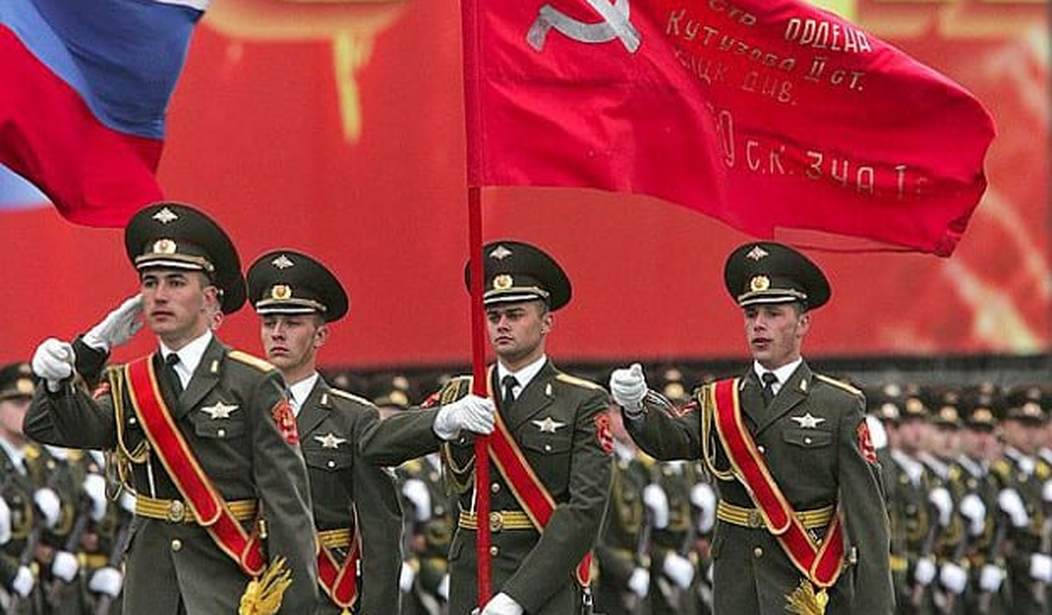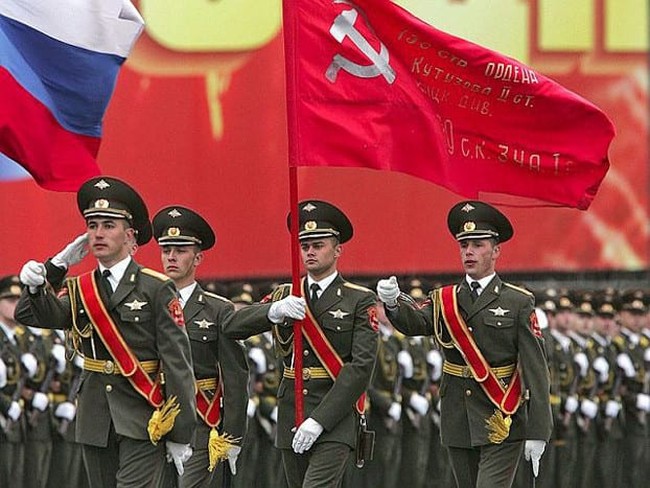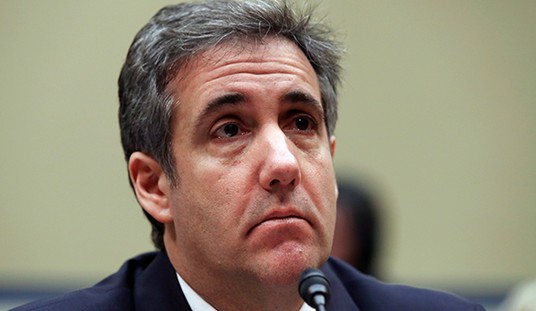There is an op-ed in the Washington Post by Mark Kramer, director of the Project on Cold War Studies at Harvard University, making the rounds today titled Five myths about the Cold War.
Like so many “Myth” themed pieces it is combination falsehoods and fields of burning straw men. Some of the myths aren’t even myths. In my view, if this actually represents the state of Cold War scholarship then four decades of American history have been as smoothly eradicated as anything contemplated by George Orwell.
We’ll take a look at the alleged myths but this is not scholarship. This seems to be part of the propaganda campaign emerging from the White House which is telling us that it is really no big deal if Russian president Vladimir Putin is snarfing up huge expanses of previously sovereign nations because Obama is On. The. Job. And this is not the Cold War.
1. During the Cold War, we knew who the enemy was.
Throughout the Cold War, fierce disagreements often arose about the nature of the threat. Debate raged in the late 1940s and 1950s about the danger posed by American communists and others with suspect loyalties. After President Harry Truman sent U.S. forces to the Korean Peninsula in 1950, some in Congress warned that getting bogged down in Asia would divert forces from the real threat Joseph Stalin posed to Europe. Protests against the Vietnam War in the 1960s and early 1970s once again raised the question of the enemy: Was it China, the Soviet Union, the Vietnamese communists? Similar questions emerged in the 1980s in debates about aid to anti-communist guerillas in Nicaragua.
America’s main target changed with the times. Mao Zedong’s China was once seen as a great danger, but after China and the Soviet Union clashed in 1969, the U.S. government pursued a far-reaching rapprochement with Beijing . The United States also established a detente with the Soviet Union in the early 1970s, as did allies in Europe. When U.S.-Soviet tensions resurfaced in the late 1970s and early 1980s, Western Europeans preserved their own detente with the Soviet bloc.
This is not a myth. It is a tendentious argument that at its core is nonsense. Of course we knew who the enemy was.
Until the Sino-Soviet schism in 1960 all communist threats, foreign and domestic, were rightfully viewed as part of a monolithic communist threat under the direction of the Soviet Union. Soviets, not Chinese, ran the intelligence apparatus that owned the West Coast longshoremen’s union and most of Hollywood. The Soviets pilfered the atom bomb. The argument about Korea was not who our enemy was, but rather one of strategy. Were we weakening our position in Europe by intervening? Many in foreign policy circles believed that Korea was a feint to draw our attention from NATO. No one doubted that the Soviets were heavily involved. The North Koreans drove T-34 tanks and Soviet Air Force pilots in Soviet MiG-15s squared off against USAF pilots in F-86s. The breach between Mao and Stalin took place, in part, because Mao believed he was promised Soviet military units to fight in Korea.
Contrary to what the author states, throughout the Cold War the primary opponent of the United States was always the Soviet Union. At no time was Communist China ever given primacy over the Soviet Union in defense planning. Even after Nixon’s rapprochement with China and détente no one lost sight of our main opponent. The USSR was the only existential threat to the United States.
Look at US military hardware. From the 1950s onwards it was optimized for killing Soviet armor in the Fulda Gao or defeating the Soviet Navy. Even today you cannot find a single weapon system that was designed to focus on any threat other than the Soviet Union and its successor state, Russia.
2. America’s winning strategy in the Cold War can be summarized in one word: containment.
U.S. foreign policy was never guided by a single strategy. In important instances, the United States did not even attempt to contain the spread of Soviet influence, instead accepting the victories achieved by communist and leftist forces. After Soviet-backed communists seized power in Czechoslovakia in 1948 and China in 1949, the United States took no military or covert action to reverse those encroachments.
[…]
Here Kramer gets the myth right but he really botches the explanation. To quote Washington Post shill and fact checker, Glenn Kessler, this is true but false. Being from Harvard, he undoubtedly views President Reagan as a bit player who scared the hell out of people whenever he wasn’t napping.
That containment won the Cold War is a myth. At its core, containment is simply slow motion defeatism. Containment is what a football team does when its game strategy is to hold an opposing running back to 200 yards rushing. Containment can’t win. No one thought containment would win because no one thought the Soviet Union would simply fold. Anyone who tells you that any credible voice in Western policy or intelligence circles accurately forecast a) how the USSR would fall and b) placed that fall in the correct decade is simply lying to you. In 1988 the CIA forecast that in ten years the USSR’s GDP would outstrip that of the USA.
Rather the strategy was to mitigate the rapacious tendencies of the USSR by offering business ventures, access to Western banking systems, etc. and hope that time and a taste for consumer goods would tame the beast. As in so many endeavors, hope is not a method.
The strategy that won the Cold War was rollback. Rollback wasn’t invented by Reagan but he carried it out with a vengeance. Rather than ceding any ground to the USSR he made them fight for it. And he also made them fight to keep what they had. While Reagan only committed conventional US ground forces to action twice, we funded proxy armies in Latin America, sub-Saharan Africa, the Horn of Africa, and Afghanistan. Between these wars and his conventional defense build up so that we had the ability to fight at a level that did not involve strategic nuclear weapons bled the USSR white.
3. Compared with today’s terrorism threat, the Cold War was a time of stability.
In May 2007, The Washington Post’s David Ignatius published a column claiming that “the bipolar world of the Cold War had an inherent stability. The two superpowers understood the rules of the game.” The post-Cold War world, he explained, “makes the Cold War seem like the good old days.”
Yet stability during the Cold War was often nonexistent. Crises repeatedly emerged between the United States and the Soviet Union, and between these countries and China, including showdowns over Turkey and Iran right after World War II, the Berlin Blockade of 1948-49, the Korean War, the Quemoy and Matsu crises of the 1950s, and the Cuban missile crisis, which brought the world close to nuclear war. And Chinese and Soviet military forces took part in operations against U.S. forces during the Vietnam War.
[…]
This is only a myth in the most superficial way. In fact, Kramer takes a cleaver to history. Crises between the great powers didn’t “repeatedly emerge.” In 1948 (Berlin Blockade), 1958 (Berlin Crisis), and 1963 (the Cuban Missile Crisis) the world teetered on the brink of another World War. From that point on neither side pushed the other to the brink though both made mischief around the edges. The rules were carefully calibrated. For instance, we had two significant provocations from North Korea, a Chinese client state. The first was the pirating of the USS Pueblo (1968) and the axe murder of two US officers inside the DMZ in 1976. We didn’t take military action because we knew this would create a crisis.
Within the framework of geopolitical stability, the Cold War was a very stable period. Between 1953 and 1991 US military units did not engage in armed conflict with the armed forces of Communist China or the Soviet Union. The author smarmily substitutes the idea of conflict between the US, USSR, and ChiComs for stability. The two are very different things.
The greater dishonesty is really to place terrorism at the same place on the conflict continuum as the stand off between the US and USSR. Even on their best day, terrorist could kill 3,000 Americans. One Soviet nuke would have multiplied that number by a thousand.
4. Costly as the arms race was, it brought a Long Peace.
The characterization of the Cold War as a “Long Peace,” a term coined in the 1980s by the historian John Gaddis, makes sense only if we overlook the devastating wars that resulted from (or were aggravated by) the Cold War. Statistics compiled by the Human Security Report Project show that the Korean War, the Vietnam War, civil wars in Central America and southern Africa, a succession of wars in the Middle East, and the Soviet war in Afghanistan resulted in the deaths of millions of people, most of whom were civilians. Millions more were slaughtered by their governments, as in Mao’s China and Pol Pot’s Cambodia. Large numbers also died under regimes in Latin America and Africa that were backed by Western governments because of Cold War pressures.
[…]
This is the type of nonsense you hear in faculty lounges. I don’t even know what it means. For the duration of the Cold War no one in policy circles ever used the term Long Peace. At best it is a non-sequitur. The arms race, itself, is a red herring. The arms race really didn’t kill people. Arguably is diverted resources from more noble pursuits. Inarguably, it provided a lot of high paying jobs. Most of the weapons procured during the arms race were scrapped without ever having been used.
In Gaddis’ article, he is clearly referring to major wars. Now, I will concede that if you are killed it makes damned little difference to you whether it was a croquet mallet wielded by an irate Obama staffer or part of a thermonuclear Armageddon. The end result is the same. The correct framing of his “myth” would be that it was a myth that fewer people died in the Cold War than in a prospective war between the US and USSR. I think even Kramer would agree that is nonsense on stilts. In that form, the statement is not a myth but a blinding flash of the obvious.
5. With Putin in Russia, the Cold War is back.
Putin’s instincts are authoritarian, and he has never outgrown his KGB years. But the country he leads is not the Soviet Union. Post-Soviet Russia is much weaker than the U.S.S.R. and is far short of a global superpower. The Russian army is only one-fifth the size of the Soviet army.
[…]
This is just dumb. This is not a “myth” about the Cold War. This is a White House propaganda point. This is a point made to deflect our gaze from what Russia is trying to do in Eastern Europe and the feckless mismanagement of our diplomacy by Barack Obama. Back in 2012, when Romney correctly, and to the non-Ivy-League observer non-controversially, pointed out that Russia was a geopolitical rival, he was hooted at. He was right then. Anyone who had followed Russia’s actions in Georgia, its dealings with Iran, its meddling in the former Yugoslavia knew Russia was out to reassemble the USSR. That has not changed and no amount of faux myth busting will change that.















Join the conversation as a VIP Member